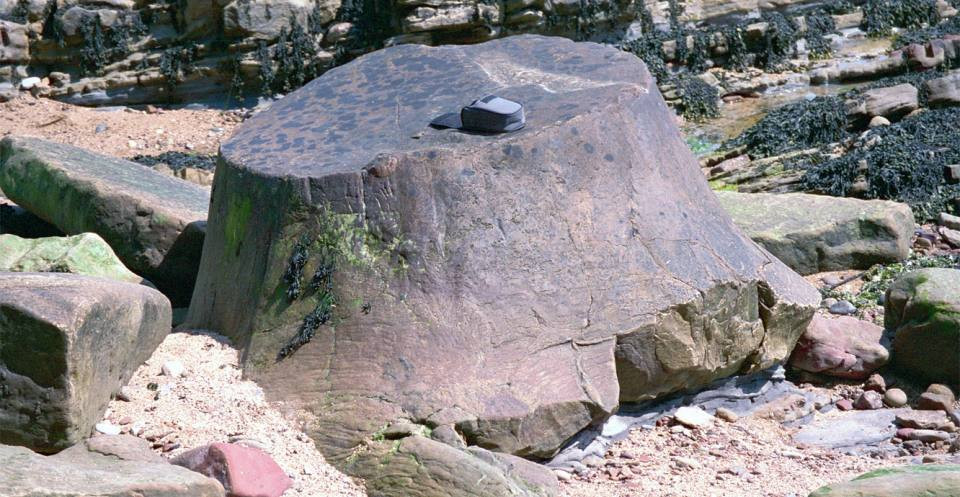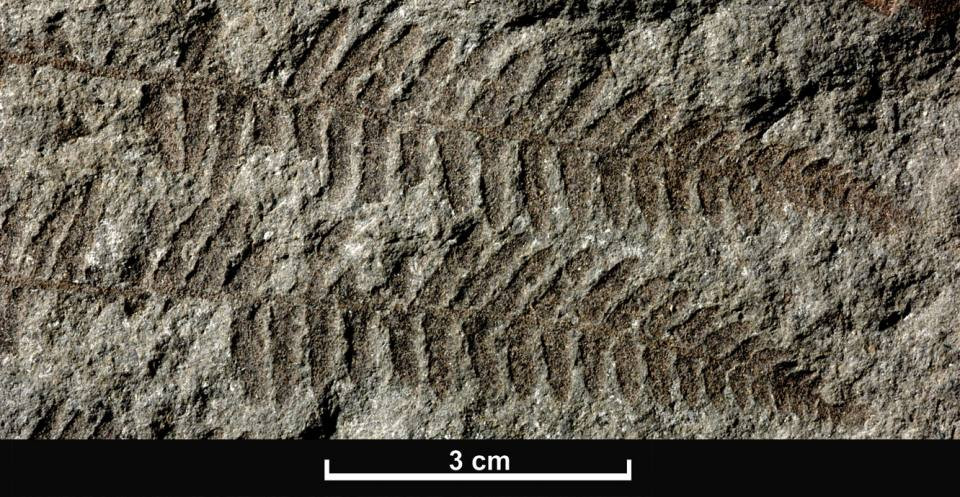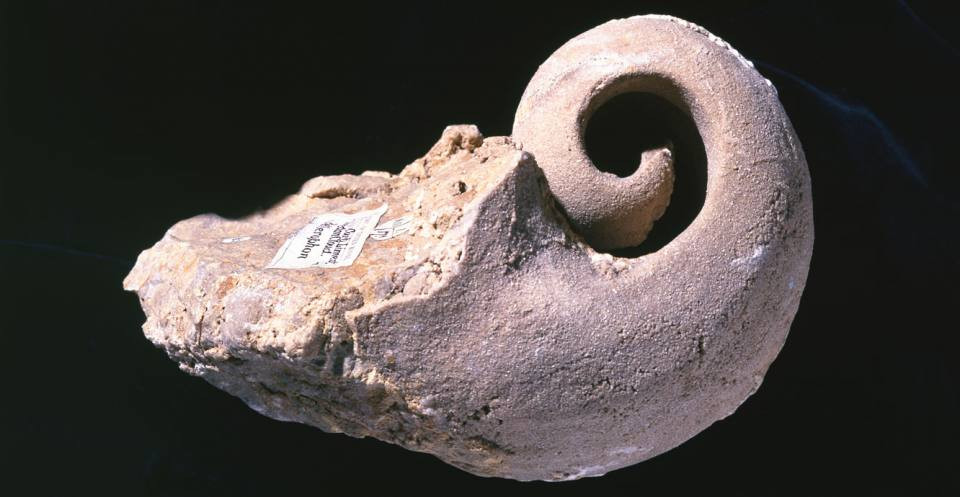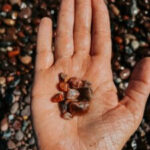Fossils, the preserved remains of ancient life, are primarily found in sedimentary rocks. Rockscapes.net is here to guide you through the fascinating world of these geological treasures, highlighting how they form and where to discover them, enhancing your landscape with history and beauty. Explore the possibilities with natural stone, decorative rocks, and stunning rock formations.
1. What are Fossils and Why Do They Matter?
Fossils are the preserved remains or traces of animals, plants, and other organisms from the remote past, typically older than 10,000 years. These relics provide invaluable insights into the history of life on Earth, revealing how organisms evolved, adapted to changing environments, and how continents were once connected. According to research from Arizona State University’s School of Earth and Space Exploration, the study of fossils allows us to understand the interconnectedness of past and present ecosystems, offering crucial context for modern environmental challenges.
1.1. Body Fossils vs. Trace Fossils
Body fossils are the preserved remains of an organism’s body, such as bones, shells, and leaves. Trace fossils, on the other hand, are the preserved evidence of an organism’s activity, like footprints, burrows, and even fossilized dung (coprolites). Both types of fossils offer unique information about ancient life.
1.2. The Significance of Fossil Study
Studying fossils helps us to:
- Understand Evolution: Fossils provide a tangible record of how life forms have changed over millions of years.
- Date Rocks: Certain fossils, known as index fossils (like ammonites), are useful for determining the age of rock layers.
- Reconstruct Past Environments: Fossils can tell us about the climate, geography, and ecosystems of the past.
- Learn About Human Origins: Fossil discoveries have been instrumental in tracing the evolution of humans and our ancestors.
2. In What Types of Rocks Are Fossils Typically Located?
Fossils are predominantly found in sedimentary rocks. These rocks are formed from the accumulation and cementation of sediments like sand, mud, and organic matter. The relatively gentle conditions under which sedimentary rocks form are conducive to the preservation of fossils.
2.1. Sedimentary Rocks: The Ideal Fossil Preservers
Sedimentary rocks are formed through the accumulation and lithification (the process of compacting sediments into rock) of sediments. This process often occurs in environments where organisms can be rapidly buried, protecting them from decay and erosion. The most common types of sedimentary rocks that contain fossils include:
- Limestone: Formed from the accumulation of calcium carbonate, often from the shells and skeletons of marine organisms.
- Shale: A fine-grained rock formed from compacted mud and clay, often preserving detailed impressions of plants and animals.
- Sandstone: Formed from cemented sand grains, sometimes containing fossils of terrestrial organisms or marine creatures in coastal environments.
2.2. Why Sedimentary Rocks?
Several factors make sedimentary rocks ideal for fossil preservation:
- Rapid Burial: Sediments can quickly bury organisms, protecting them from scavengers and decomposition.
- Permineralization: Mineral-rich waters can seep through sediments, filling pores in bones and shells and eventually replacing the organic material with minerals.
- Low Heat and Pressure: Unlike igneous and metamorphic rocks, sedimentary rocks form under relatively low heat and pressure, which minimizes the destruction of organic remains.
3. Which Specific Sedimentary Rocks Are Most Likely to Contain Fossils?
While fossils can be found in various sedimentary rocks, some are more likely to contain them than others. Let’s explore these fossil-rich rock types in detail.
3.1. Limestone: A Marine Fossil Haven
Limestone is primarily composed of calcium carbonate (CaCO3), which often originates from the shells and skeletons of marine organisms like corals, shellfish, and microscopic plankton. As these organisms die, their remains accumulate on the seafloor, forming layers of sediment that eventually lithify into limestone. This makes limestone an excellent place to find marine fossils.
- Common Limestone Fossils:
- Brachiopods: These are marine animals with hinged shells, similar to clams.
- Corals: Both colonial and solitary corals can be found in limestone, providing insights into ancient reef ecosystems.
- Crinoids: Also known as sea lilies, these are marine animals related to starfish and sea urchins.
- Foraminifera: These are microscopic, single-celled organisms with shells that are abundant in marine sediments.
- Ammonites: These extinct cephalopods with coiled shells are often found in limestone.
3.2. Shale: A Fine-Grained Treasure Trove
Shale is a fine-grained sedimentary rock composed of compacted mud and clay. Its fine texture allows it to preserve delicate details of fossils, such as the imprints of leaves, feathers, and soft-bodied organisms. Shale often forms in quiet, low-energy environments like lakebeds and deep ocean basins.
- Common Shale Fossils:
- Trilobites: These extinct marine arthropods are frequently found in shale, often with exquisite detail.
- Graptolites: These extinct colonial organisms are common in shale from the Paleozoic Era.
- Plant Fossils: Leaves, stems, and even entire plants can be preserved in shale, providing a glimpse into ancient terrestrial ecosystems.
- Fish Fossils: The fine-grained nature of shale can preserve the delicate bones and scales of ancient fish.
- Insects: In rare cases, shale can preserve the impressions of insects and other small invertebrates.
3.3. Sandstone: Coastal and Terrestrial Records
Sandstone is formed from cemented sand grains, typically composed of quartz. While not as rich in fossils as limestone or shale, sandstone can still contain valuable fossil finds, especially in coastal or fluvial (river) environments.
- Common Sandstone Fossils:
- Dinosaur Footprints: Sandstone is an excellent medium for preserving the footprints of dinosaurs and other ancient reptiles.
- Burrows: The burrows of marine or terrestrial animals can be preserved in sandstone, providing evidence of their behavior.
- Fossilized Wood: Petrified wood, where the organic material has been replaced by minerals, is often found in sandstone.
- Shells: In coastal sandstones, the shells of marine organisms like clams and snails can be preserved.
4. How Does Fossilization Occur in Rocks?
Fossilization is a rare and complex process that requires specific conditions to occur. Let’s delve into the various ways organisms can be preserved as fossils in rock.
4.1. Permineralization: Turning Organic Matter into Stone
Permineralization is the most common type of fossilization. It occurs when mineral-rich fluids seep through the pores of buried bones, shells, or plant material. These fluids deposit minerals like calcium carbonate, silica, or iron oxides within the pores, gradually filling them. Over time, the minerals can completely replace the original organic material, turning the fossil into stone.
- The Process:
- An organism dies and is buried by sediment.
- Porous remains are exposed to mineral-rich fluids.
- Minerals precipitate within the pores, filling the spaces.
- The original organic material is gradually replaced by minerals.
- The fossil becomes petrified, or turned into stone.
4.2. Compression: Flattening and Preserving
Compression occurs when an organism is buried under layers of sediment and subjected to intense pressure. The pressure flattens the organism, leaving behind a two-dimensional imprint in the rock. This type of fossilization is common for plant fossils, where the leaves and stems are compressed into thin, carbonaceous films.
- The Process:
- An organism, typically a plant, is buried by sediment.
- The weight of overlying sediments exerts pressure on the organism.
- The organism is flattened, leaving a thin, carbon-rich imprint.
- The surrounding sediment hardens into rock, preserving the compressed fossil.
4.3. Molds and Casts: Leaving an Impression
Molds and casts are formed when an organism is buried in sediment, and its remains dissolve away, leaving a cavity in the rock (the mold). If this cavity is later filled with sediment or minerals, it forms a cast, which is a three-dimensional replica of the original organism.
- The Process:
- An organism is buried in sediment.
- The organism’s remains dissolve away, leaving a mold.
- The mold is filled with sediment or minerals, forming a cast.
- The surrounding sediment hardens into rock, preserving the mold and cast.
4.4. Preservation: Encased in Amber, Ice, or Tar
In rare cases, organisms can be preserved in their entirety, with their original soft tissues intact. This can occur when organisms are trapped in amber (fossilized tree resin), frozen in ice, or immersed in tar pits. These environments protect the organisms from decay and scavengers, allowing for exceptional preservation.
- Examples:
- Insects in Amber: Insects trapped in sticky tree resin can be perfectly preserved as the resin hardens into amber.
- Mammoths in Ice: Woolly mammoths and other Ice Age animals have been found frozen in the permafrost of Siberia and Alaska, with their fur, skin, and internal organs intact.
- Animals in Tar Pits: The La Brea Tar Pits in Los Angeles have preserved the bones of thousands of animals, including saber-toothed cats, dire wolves, and mammoths.
5. Where Can You Find Fossils in the United States?
The United States is a treasure trove of fossils, with numerous locations where you can discover these remnants of ancient life. Here are some of the most famous and productive fossil sites in the country.
5.1. The Western United States: A Fossil Hotspot
The western United States is renowned for its abundant and diverse fossil record, thanks to its rich geological history and varied environments.
- The Morrison Formation: This vast geological formation stretches across several western states, including Colorado, Wyoming, Utah, and Montana. It is famous for its dinosaur fossils, including iconic species like Stegosaurus, Apatosaurus, and Allosaurus.
- The Green River Formation: Located in Wyoming, Colorado, and Utah, the Green River Formation is known for its exceptionally well-preserved fish fossils, as well as insects, plants, and other organisms from the Eocene Epoch.
- The John Day Fossil Beds National Monument: In Oregon, this national monument preserves a stunning array of fossils from the Oligocene and Miocene Epochs, including mammals, birds, and plants.
- The La Brea Tar Pits: Situated in Los Angeles, California, the La Brea Tar Pits have yielded a wealth of Ice Age fossils, including mammoths, saber-toothed cats, and dire wolves.
5.2. The Eastern United States: Ancient Marine Life
The eastern United States also boasts a rich fossil record, particularly of marine life from the Paleozoic Era.
- The Burgess Shale: While technically located in British Columbia, Canada, the Burgess Shale is part of a larger geological formation that extends into the United States. It is famous for its exceptionally well-preserved soft-bodied organisms from the Cambrian Period.
- The Calvert Cliffs: Along the Chesapeake Bay in Maryland, the Calvert Cliffs expose layers of sediment from the Miocene Epoch, containing fossils of marine mammals, sharks, and other marine creatures.
- The Pennsylvanian Coal Forests: In states like Pennsylvania, West Virginia, and Illinois, the coal forests of the Pennsylvanian Period have yielded abundant plant fossils, including ferns, seed ferns, and early trees.
5.3. The Central United States: A Mix of Terrestrial and Marine Fossils
The central United States offers a mix of terrestrial and marine fossils, reflecting its varied geological history.
- The Agate Fossil Beds National Monument: Located in Nebraska, this national monument preserves the fossils of Miocene mammals, including rhinoceroses, horses, and camels.
- The Niobrara Formation: Found in Kansas, Nebraska, and South Dakota, the Niobrara Formation is known for its marine fossils, including mosasaurs, plesiosaurs, and pterosaurs.
6. Utilizing Fossils in Landscaping: A Touch of Ancient History
Adding fossils to your landscape design can create a unique and captivating space that blends natural beauty with a sense of history. Here are some ways to incorporate fossils into your outdoor environment:
6.1. Fossil-Embedded Stone Pathways
Create a pathway using flagstones or pavers that contain fossil impressions. These stones will add a touch of ancient history to your garden and provide a conversation starter for visitors.
6.2. Fossil-Studded Rock Gardens
Incorporate fossil-rich rocks into your rock garden design. These rocks can serve as focal points, adding visual interest and a sense of geological wonder to your landscape.
6.3. Fossil-Decorated Water Features
Adorn your water features, such as ponds or fountains, with fossil-bearing stones. The combination of water and fossils can create a serene and captivating atmosphere.
6.4. Fossil Display Areas
Create dedicated display areas for your fossil collection. These areas can be designed to showcase your favorite specimens and provide educational information about their origins.
6.5. Enhancing Curb Appeal with Rockscapes.net
At Rockscapes.net, we’re dedicated to helping you create stunning landscapes that reflect your unique style and vision. Whether you’re looking for inspiration, guidance, or high-quality materials, we’re here to support you every step of the way.
- Explore Our Extensive Collection: Discover a wide range of natural stones, decorative rocks, and landscape supplies to bring your design ideas to life.
- Get Expert Advice: Consult with our team of experienced landscape professionals to get personalized recommendations and design tips.
- Find Local Suppliers: Connect with trusted suppliers in your area to source the materials you need for your project.
By integrating fossils into your landscape design, you can create an outdoor space that is both beautiful and educational, connecting you and your visitors to the deep history of our planet.
7. What Are Some Challenges in Finding Fossils?
Finding fossils isn’t always easy. Many factors can influence where fossils are located and how accessible they are. It’s essential to be aware of these challenges to improve your chances of a successful fossil hunt.
7.1. Rock Type
As mentioned earlier, fossils are primarily found in sedimentary rocks. Therefore, the first challenge is identifying areas with sedimentary rock formations. This requires geological knowledge or consulting geological maps.
7.2. Erosion and Weathering
Erosion and weathering can both expose and destroy fossils. While erosion can reveal fossils by removing overlying layers of sediment, it can also damage them through physical abrasion and chemical dissolution.
7.3. Vegetation and Overburden
Dense vegetation and thick layers of soil (overburden) can obscure rock outcrops and make it difficult to find fossils. Removing vegetation or excavating overburden may be necessary to access fossil-bearing rocks.
7.4. Private Property and Regulations
Many fossil sites are located on private property, requiring permission from the landowner to access. Additionally, some areas may be protected by regulations that restrict or prohibit fossil collecting. It’s crucial to research and comply with all applicable laws and regulations before fossil hunting.
7.5. Fossil Identification
Once you’ve found a potential fossil, identifying it can be challenging. Fossil identification requires knowledge of paleontology and comparative anatomy. Consulting with experts or using field guides can help you identify your finds.
8. What Type of Rocks Can I Use To Accentuate The Fossils I Find?
Selecting the right type of rocks to accentuate your fossil finds can greatly enhance their visual appeal and create a cohesive landscape design. Here are some rock types that pair well with fossils:
8.1. Complementary Colors
Choose rocks with colors that complement the colors of your fossils. For example, if your fossils are light-colored, consider using darker rocks like basalt or slate to create contrast.
8.2. Textural Contrast
Mix rocks with different textures to add visual interest to your landscape. For example, pair smooth, rounded river rocks with rough, angular fossil-bearing rocks.
8.3. Local Geology
Select rocks that are native to your region. This will create a sense of place and ensure that your landscape blends seamlessly with the surrounding environment.
8.4. Rock Size and Shape
Consider the size and shape of your rocks when arranging them around your fossils. Use larger rocks to create a backdrop or frame for your fossils, and smaller rocks to fill in gaps and add detail.
8.5. Rockscapes.net for All Your Rock Needs
Rockscapes.net offers a wide variety of rocks and landscape supplies to help you create the perfect setting for your fossil finds. Browse our online catalog or visit our showroom to explore our extensive collection.
9. How Can I Maintain the Rocks Where Fossils Have Been Placed?
Proper maintenance is essential to preserve the beauty and integrity of your fossil-bearing rocks. Here are some tips for caring for your fossil-enhanced landscape:
9.1. Cleaning
Regularly clean your rocks to remove dirt, algae, and other debris. Use a soft brush and mild soap to gently scrub the rocks. Avoid using harsh chemicals or abrasive cleaners, which can damage the fossils.
9.2. Sealing
Consider sealing your rocks with a stone sealant to protect them from weathering and staining. Choose a sealant that is appropriate for the type of rock and the climate in your area.
9.3. Weed Control
Keep weeds away from your rocks to prevent them from becoming overgrown and obscuring your fossils. Use a combination of manual weeding and herbicides to control weeds.
9.4. Erosion Control
Prevent erosion around your rocks by installing retaining walls, terraces, or other erosion control measures. This will help to keep your rocks in place and prevent them from being buried or damaged.
9.5. Professional Maintenance
For large or complex landscapes, consider hiring a professional landscape maintenance company to care for your rocks and fossils.
10. Frequently Asked Questions (FAQ) About Fossils in Rocks
Here are some frequently asked questions about fossils in rocks:
10.1. What is a fossil?
A fossil is the preserved remains or traces of an animal, plant, or other organism from the past, typically older than 10,000 years.
10.2. What types of rocks are fossils found in?
Fossils are most commonly found in sedimentary rocks, such as limestone, shale, and sandstone.
10.3. How does fossilization occur?
Fossilization can occur through permineralization, compression, molds and casts, or preservation in amber, ice, or tar.
10.4. Where can I find fossils in the United States?
Fossils can be found in many locations across the United States, including the Morrison Formation, the Green River Formation, and the La Brea Tar Pits.
10.5. Can I use fossils in my landscape design?
Yes, fossils can be incorporated into landscape designs to add a touch of ancient history and visual interest.
10.6. How can I accentuate the fossils I find?
Choose rocks with complementary colors, textural contrast, and local geology to accentuate your fossil finds.
10.7. How can I maintain the rocks where fossils have been placed?
Regularly clean, seal, and weed your rocks to preserve their beauty and integrity.
10.8. Is it legal to collect fossils?
Fossil collecting regulations vary depending on the location. It’s essential to research and comply with all applicable laws and regulations before fossil hunting.
10.9. How can I identify a fossil?
Fossil identification requires knowledge of paleontology and comparative anatomy. Consulting with experts or using field guides can help you identify your finds.
10.10. Where can I find rocks and landscape supplies for my fossil-themed landscape?
Rockscapes.net offers a wide variety of rocks and landscape supplies to help you create the perfect setting for your fossil finds. Address: 1151 S Forest Ave, Tempe, AZ 85281, United States. Phone: +1 (480) 965-9011. Website: rockscapes.net.
Ready to bring the wonder of fossils into your landscape? Visit Rockscapes.net today to explore our extensive collection of rocks and landscape supplies. Let us help you create an outdoor space that is both beautiful and educational, connecting you and your visitors to the deep history of our planet. Discover design ideas, get expert advice, and find local suppliers. Start your fossil-themed landscape project with rockscapes.net today.
 This tree stump, found in East Fife, Scotland, is a good example of a petrified tree fossil produced by permineralisation.
This tree stump, found in East Fife, Scotland, is a good example of a petrified tree fossil produced by permineralisation.
 Plant leaves and ferns are good examples of fossils produced by compression. This image shows Coniopteris is a genus of true fern, or pteropsid, fossil from the Jurassic Period.
Plant leaves and ferns are good examples of fossils produced by compression. This image shows Coniopteris is a genus of true fern, or pteropsid, fossil from the Jurassic Period.
 This image is a mould of an ancient snail or slug called Bellerophon, a gastropod. Fossils can form when mould of the interior of the shell is made by water-borne minerals percolating through it, but later the shell material dissolves away.
This image is a mould of an ancient snail or slug called Bellerophon, a gastropod. Fossils can form when mould of the interior of the shell is made by water-borne minerals percolating through it, but later the shell material dissolves away.
